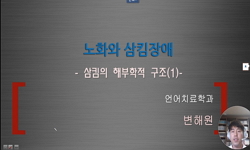Many children with physical disability have feeding difficulties. In cases of children with cerebral palsy, feeding difficulties can be seen in abnormal oral motor activity and defective swallowing coordination. These problems originate from neurolog...
http://chineseinput.net/에서 pinyin(병음)방식으로 중국어를 변환할 수 있습니다.
변환된 중국어를 복사하여 사용하시면 됩니다.
- 中文 을 입력하시려면 zhongwen을 입력하시고 space를누르시면됩니다.
- 北京 을 입력하시려면 beijing을 입력하시고 space를 누르시면 됩니다.
https://www.riss.kr/link?id=A75174346
- 저자
- 발행기관
- 학술지명
- 권호사항
-
발행연도
1999
-
작성언어
Korean
- 주제어
-
등재정보
KCI등재
-
자료형태
학술저널
- 발행기관 URL
-
수록면
25-37(13쪽)
-
비고
학회 요청에 의해 무료로 제공
- 제공처
-
0
상세조회 -
0
다운로드
부가정보
다국어 초록 (Multilingual Abstract)

palsy, feeding difficulties can be seen in abnormal oral motor activity and defective swallowing coordination. These problems originate from neurological lesions. The purpose of this study was to investigate the effect of trunk and neck position on the following aspects of swallowing: stages of oral preparation, pharyngeal swallowing reflex, pharyngeal clearing and aspiration.
Sixteen subjects with quadriplegic cerebral palsy were examined to assess their swal-lowing ability using videofluoroscopy(VFS). Subjects were evaluated in four different positions 1) trunk erect with the neck flexed 30°2) trunk reclined 30°posteriorly with the eck positioned neutrally 3) trunk reclined 30°posteriorly with the neck flexed 30°
4) trunk in supine with the neck flexed 30°. Friedman's test was used to analyze the effect of posi
tion of the neck and trunk on swallowing.
The results were as follows:
1. Ability of oral preparation was significantly better with the subject's trunk recli-ned 30°posteriorly and the neck flexed 30°than with the trunk erect and the neck flexed 30°(p < 0.05).
2. Ability of pharyngeal clearing was significantly better with the subject's trunk er-ect and the
neck flexed 30° than in supine with the neck flexed 30°(p < 0.05).
3. Incidence of swallowing reflex was not significantly different among the four posi- tions (p >0.05).
4. Prevention of aspiration was significantly better with the subject's trunk reclined 30°posteriorl
y and the neck flexed 30° than with the trunk reclined 30°posteriorly and the neck neutrally positi
oned or in supine with the neck flexed 30°(p < 0.05).
These results suggest that positions of both the neck and the trunk have an effect on swallowing in children with cerebral palsy. The position with the trunk reclined 30°posteriorly and the n
eck flexed 30°was found to be optimal for oral preparation and prevention of aspiration. Further research to study swallowing ability in conjunc- tion with respiratory function is indicated.
Many children with physical disability have feeding difficulties. In cases of children with cerebral
palsy, feeding difficulties can be seen in abnormal oral motor activity and defective swallowing coordination. These problems originate from neurological lesions. The purpose of this study was to investigate the effect of trunk and neck position on the following aspects of swallowing: stages of oral preparation, pharyngeal swallowing reflex, pharyngeal clearing and aspiration.
Sixteen subjects with quadriplegic cerebral palsy were examined to assess their swal-lowing ability using videofluoroscopy(VFS). Subjects were evaluated in four different positions 1) trunk erect with the neck flexed 30°2) trunk reclined 30°posteriorly with the eck positioned neutrally 3) trunk reclined 30°posteriorly with the neck flexed 30°
4) trunk in supine with the neck flexed 30°. Friedman's test was used to analyze the effect of posi
tion of the neck and trunk on swallowing.
The results were as follows:
1. Ability of oral preparation was significantly better with the subject's trunk recli-ned 30°posteriorly and the neck flexed 30°than with the trunk erect and the neck flexed 30°(p < 0.05).
2. Ability of pharyngeal clearing was significantly better with the subject's trunk er-ect and the
neck flexed 30° than in supine with the neck flexed 30°(p < 0.05).
3. Incidence of swallowing reflex was not significantly different among the four posi- tions (p >0.05).
4. Prevention of aspiration was significantly better with the subject's trunk reclined 30°posteriorl
y and the neck flexed 30° than with the trunk reclined 30°posteriorly and the neck neutrally positi
oned or in supine with the neck flexed 30°(p < 0.05).
These results suggest that positions of both the neck and the trunk have an effect on swallowing in children with cerebral palsy. The position with the trunk reclined 30°posteriorly and the n
eck flexed 30°was found to be optimal for oral preparation and prevention of aspiration. Further research to study swallowing ability in conjunc- tion with respiratory function is indicated.
목차 (Table of Contents)
- Ⅰ. 서 론
- Ⅱ. 연구 방법
- 1. 연구 대상
- 2. 실험 기구 및 측정 방법
- 3. 실험 과정
- Ⅰ. 서 론
- Ⅱ. 연구 방법
- 1. 연구 대상
- 2. 실험 기구 및 측정 방법
- 3. 실험 과정
- 4. 분석 방법
- Ⅲ. 연구결과
- 1. 연구 대상자의 일반적 특성
- 2. 구강단계의 음식 조절 능력 비교
- 3. 인두단계의 음식 제거 능력 비교
- 4. 인두단계의 삼킴반사 능력 비교
- 5. 인두단계의 흡인 정도 비교
- Ⅳ. 고 찰
- Ⅴ. 결 론
동일학술지(권/호) 다른 논문
-
- 대한작업치료학회
- 정원미
- 1999
- KCI등재
-
LAP를 이용한 장애 아동의 발달 평가 : 하위항목간의 상관관계 연구
- 대한작업치료학회
- 홍재란
- 1999
- KCI등재
-
고관절각도 변화가 경직성 하지 뇌성마비 아동의 손 기능에 미치는 영향
- 대한작업치료학회
- 유은영
- 1999
- KCI등재
-
뇌성마비 장애인의 일상생활동작 수행능력과 우울간의 관계
- 대한작업치료학회
- 이미자
- 1999
- KCI등재





 eArticle
eArticle 코리아스칼라
코리아스칼라






